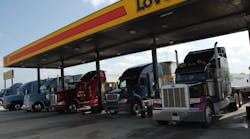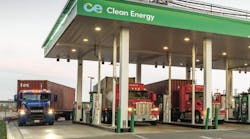Diesel and gasoline prices continued climbing this week across the U.S., according to data tracked by the Energy Information Administration (EIA), largely due to rising oil prices being spurred higher by increased demand and near-term supply worries.
The national average pump price for diesel jumped 6.8 cents this week to $2.266 per gallon, EIA noted, though that’s 58.8 cents cheaper per gallon compared to the same week in 2015.
Diesel pump prices increased in every region of the country, the agency said, with prices jumping over 7 cents per gallon in four of them:
- The Midwest: up 7.6 cents to $2.232 per gallon;
- The West Coast: up 7.5 cents to $2.481 with California included and up 7.5 cents to $2.357 with California excluded;
- California: up 7.4 cents to $2.579;
- The Lower Atlantic: up 7.3 cents to $2.232.
The national average pump price for gasoline shot up 7.8 cents this week to $2.240 per gallon, according to EIA’s numbers, though that’s 42.4 cents per gallon cheaper compared to the same week in 2015.
Gasoline prices increased in every region of the country, the agency said, with the highest spikes in four different areas:
- The Lower Atlantic: up 11.2 cents to $2.163 per gallon;
- The East Coast: up 8.9 cents to $2.215, driven largely by the hike in Lower Atlantic region gasoline prices;
- The Midwest: up 8.6 cents to $2.183;
- The Gulf Coast: up 8.2 cents to $1.995.
The ongoing increase in diesel and gasoline fuel prices is being fueled mainly by rising oil prices, which witnessed an uptick throughout April this year in response to near-term supply concerns and “a more positive economic outlook” that suggests higher crude oil demand, EIA noted in a separate report.
“The stronger crude oil demand outlook is likely the main reason for higher crude prices across the entire futures curve, whereas the near-term supply concerns are putting additional upward pressure on prices for near-term delivery,” the agency noted in its most recent petroleum market update.
Since April 1, “front-month” futures prices for Brent and West Texas Intermediate (WTI) global crude oil benchmark prices increased by more than $6 per barrel, EIA noted, with a collaborative production cut or “freeze” of production rates among members of the Organization of the Petroleum Exporting Countries (OPEC) and other major producers the main issue.
The agency noted that in its most recent Short-Term Energy Outlook (STEO), it assumed no collaborative production cut or freeze and projected major OPEC and non-OPEC producers would continue their strategy of maintaining market share.
Recent supply disruptions are also likely to be affecting oil markets, EIA said, with such “disruptions” such as a Kuwaiti oil workers strike coming at a time when non-OPEC production is decreasing and OPEC surplus crude oil production capacity is narrowing. EIA currently expects OPEC surplus capacity to average 1.8 million barrels per day in 2016.



